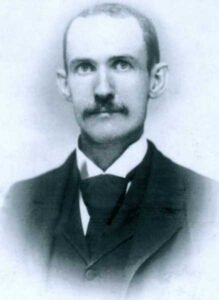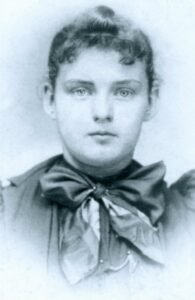
1.3.1.6.7 William Andrew Kessler (b: 29 May 1859, Jefferson Township, Md- 19 Jun 1925)


William Andrew Kessler married Alberta Gertrude Castle (16 Oct 1875-1 Jan 1934) likely in 1893. They had eight children. As Andrew Jr’s youngest child, William was “caught up” in the financial scandal that rocked the family after Andrew Jr’s death in 1896. William and Alberta moved in with William’s oldest sister Isabella and her husband, William Figgins and helped them operate their farm.
William Andrew Kessler was born a few years after the end of the Civil War, at a time when the family was prosperous. He likely grew up on one of the farms in Jefferson Township. He was the youngest of seven children born to Andrew Kessler Jr. and Alberta Lamar Kessler
William’s oldest sister, Isabella, was 21 years old when he was born in 1959, the same year in which she married William Figgins. William likely was closest to Eugenia, 7 years older and John, three years older.
William Andrew Kessler was born two years before the start of the Civil War, at a time when the family was prosperous. He likely grew up on one of the farms in Jefferson Township. He was the youngest of seven children born to Andrew Kessler Jr. and Alberta Lamar Kessler.
The Kessler family was financially secure during the mid-to-late 1800s. William’s older siblings, however, over a period of years, perhaps due to poor farming skills or unexpected crop losses, slowly withdrew and spent the family wealth, without their father Andrew Jr’s knowledge. When the assets were spent, the brothers secured loans using the family farms as collateral. When the loans could not be repaid, the bank was forced to seize and auction the farms. Andrew Jr. for a long time was unaware of the financial calamity. He was summoned to his bank in Frederick and learned about the situation. He was so distraught that he had a heart attack upon leaving the bank, collapsed on the sidewalk, and died shortly thereafter.
After Andrew Jr’s death, his children were forced to deal with the consequences of their actions, finding work and lodging where they could do so. William and Alberta moved their family to Buckeystown to live on a farm owned by William’s older sister, Isabella and her husband William Figgins. According to the 1900 US Census, they lived on William Figgins’ farm in Buckeystown. This is likely where they were living when their oldest son, Edgar Franklin Kessler was born in 1897.
HISTORICAL CONTEXT – INDUSTRIAL REVOLUTION
The period from 1866 at the end of the Civil War to 1901 and the beginning of the Spanish-America War was known as the “Gilded Age.” This period was the time when William grew up in Frederick, Maryland.
The Gilded Age and the first years of the twentieth century were a time of great social change and economic growth in the United States. This period saw rapid industrialization, urbanization, the construction of great transcontinental railroads, innovations in science and technology, and the rise of big business. Afterward, the first years of the new century that followed were dominated by progressivism, a forward-looking political movement that attempted to redress some of the ills that had arisen during the Gilded Age. Progressives passed legislation to rein in big business, combat corruption, free the government from special interests, and protect the rights of consumers, workers, immigrants, and the poor. Some historians have dubbed the presidents of the Gilded Age the “forgotten presidents,” and indeed many Americans today have trouble remembering their names, what they did for the country, or even in which era they served. These six men—Ulysses S. Grant, Rutherford B. Hayes, James Garfield, Chester Arthur, Grover Cleveland, and Benjamin Harrison—had relatively unremarkable terms in office and faced few if any major national crises during their presidencies. Some historians have suggested that these Gilded Age presidents were unexciting for a reason—because Americans wanted to avoid bold politicians who might ruin the delicate peace established after the Civil War.
Driven by the North, which emerged from the Civil War an industrial powerhouse, the United States experienced a flurry of unprecedented growth and industrialization during the Gilded Age, with a continent full of seemingly unlimited natural resources and driven by millions of immigrants ready to work. In fact, some historians have referred to this era as America’s second Industrial Revolution, because it completely changed American society, politics, and the economy. Mechanization and marketing were the keys to success in this age: companies that could mass-produce products and convince people to buy them accumulated enormous amounts of wealth, while companies that could not were forced out of business by brutal competition.
Railroads were the linchpin in the new industrialized economy. The railroad industry enabled raw materials, finished products, food, and people to travel cross-country in a matter of days, as opposed to the months or years that it took just prior to the Civil War. By the end of the war, the United States boasted some 35,000 miles of track, mostly in the industrialized North. By the turn of the century, that number had jumped to almost 200,000 miles, linking the North, South, and West. With these railroads making travel easier, millions of rural Americans flocked to the cities, and by 1900, nearly 40 percent of the population lived in urban areas.
By the twentieth century, the rise of big business and the large migration of Americans from the countryside to the cities caused a shift in political awareness, as elected officials saw the need to address the growing economic and social problems that developed along with the urban boom. Progressives believed that the government needed to take a strong, proactive role in the economy, regulating big business, immigration, and urban growth. These middle-class reformers hoped ultimately to regain control of the government from special interests like the railroads and trusts and pass effective legislation to protect consumers, organized labor, and minorities.
US Census Details:
- 1860: Jefferson, Frederick County, Md. (19/38 20 Jul) Andrew Kessler 42 (farmer), Laura 44, Isabella 22, Laura 18, Edwin 15, Thomas 11, Ugenia 9, Franklin 5, William 1, Darnell William 23 (laborer)
- 1870: Jefferson, Frederick County, Md, )13/38 29 Jul) Andrew Kessler 53 (farmer), Loretta S. 54, Edmund M. 25, Thomas A. 21, Virginia E. 18, John F. 15, William A. 11, Emma Lighter 19, Jacob Martial 64 (plus four blacks – Mima 45, Joanna 18, Mountjoy 15, & Charles 13
- 1880: Jefferson, Frederick County, Md. (17/33 15 Jul) Andrew Kessler 63 (farmer), Lauretta 63, Thomas 30, John 24, William 21, William Figgins 44, Isabel Figgins 40, Jemima Cecile 59, Charles Davis 20, Cora Speaks 6
- 1900: District 0026 Jefferson, Frederick County, Md. (18/30 Jun 16) William A. Figgins 65 (May 1835 farmer), Isabella 62 (Mar 1838), William A. Kessler 41 (brother-in-law May 1859), Alberta G. 23 (Oct 1876), Blanche M. 6 (Nov 1893), Edgar F. 3 (Feb 1897), Nellie V. 2 (Mar 1898), Clara E. 1 (Apr 1899)
- 1910: District 0047 Buckeystown, Frederick County, Md. (21/32 April 21) William A. Kessler 45 (laborer-odd jobs), Alberta G. 33, Blanche M. 16, Edgar F. 13, Nellie V. 12, Charles L. 9, Mabel L. 7, Anna L. 6, Paul 5/12
- 1920: District 0054 Buckeystown, Frederick County, Md. (11/24 Mar 3) William A. Kessler 60 (painting), Alberta G. 43, Edgar F. 23 (painting), Charles L. 19, Mabel L. 16, Anna L. 15, Paul 10, William 6
American Generation #5
William Andrew Kessler, Wife and Children
- 1.3.1.6.7 William Andrew Kessler (b: 29 May 1869, Jefferson Township, Md- 19 Jun 1925)
- 1.3.1.6.7a Alberta Gertrude Castle Kessler (b: 16 Oct 1875-d: 2 Jan 1934 Baltimore, Md)
Children
- 1.3.1.6.7.1 Blanche Mae Kessler Schaeffer (b: 21 Nov 1893 Jefferson, Md-d:30 Aug 1969 Buckeystown, Md)
- Married Wesley F. Schaeffer on Aug 13, 1913
- 1.3.1.6.7.2 Edgar Franklin Kessler Sr. (b: 5 Feb 1897 Jefferson, Md-d:29 Oct 1966 Baltimore, Md)
- 1.3.1.6.7.3 Nellie Virginia ‘Hillie’ Kessler Miss (b: Mar 1898 Jefferson, Md-d:25 May 1967 Buckeystown, Md)
- Married Ernest Peter Miss
- 1.3.1.6.7.4 Clara Elizabeth Kessler Stup (b: 25 Apr 1899 Jefferson, Md-d:15 Oct 1976 Frederick County, Md)
- Married Harry Edward Stup
- 1.3.1.6.7.5 Charles Lee ‘Charlie’ Kessler (b: 29 Nov 1900 Jefferson, Md-d:21 Jan 1949 Baltimore, Md)
- 1.3.1.6.7.6 Mabel Lauretta Kessler Diller (b: 20 Aug 1902 Jefferson, Md-d:18 Mar 1968 Md)
- Married Charles Emory Diller
- 1.3.1.6.7.7 Anna Laura ‘Annie’ Kessler Hargett Florey (b: 4 Apr 1904 Jefferson, Md-d:22 Nov 1947 Baltimore Md)
- Married Earl Fenton Hargett on 27 Jul 1920
- Married Louis Jacob Florey
- 1.3.1.6.7.8 Paul Kenderson Kessler (b: 20 Nov 1909 Jefferson, Md-d:16 May 1972 Baltimore, Md)
- 1.3.1.6.7.9 William Lawrence Kessler (b: 15 Jan 1914 Jefferson, Md-d:23 Sep 1975 Frederick, Md)
MATERNAL ANCESTRY: ALBERTA CASTLE
Alberta was the fourth of 12 children born to Kenderson T. (1848-1929) and Elizabeth Ann Young Castle (1849-1915). She was born in Middletown, Frederick County, Maryland on October 16, 1876, and married William Kessler on December 22, 1892, at the young age of 16. They were married at the Evangelical Lutheran Church in Frederick County, Maryland. Alberta died at age 57 on January 2, 1934, and was buried in Mt. Olivet Cemetery in Frederick County. She and William parented nine children from 1893 to 1910.